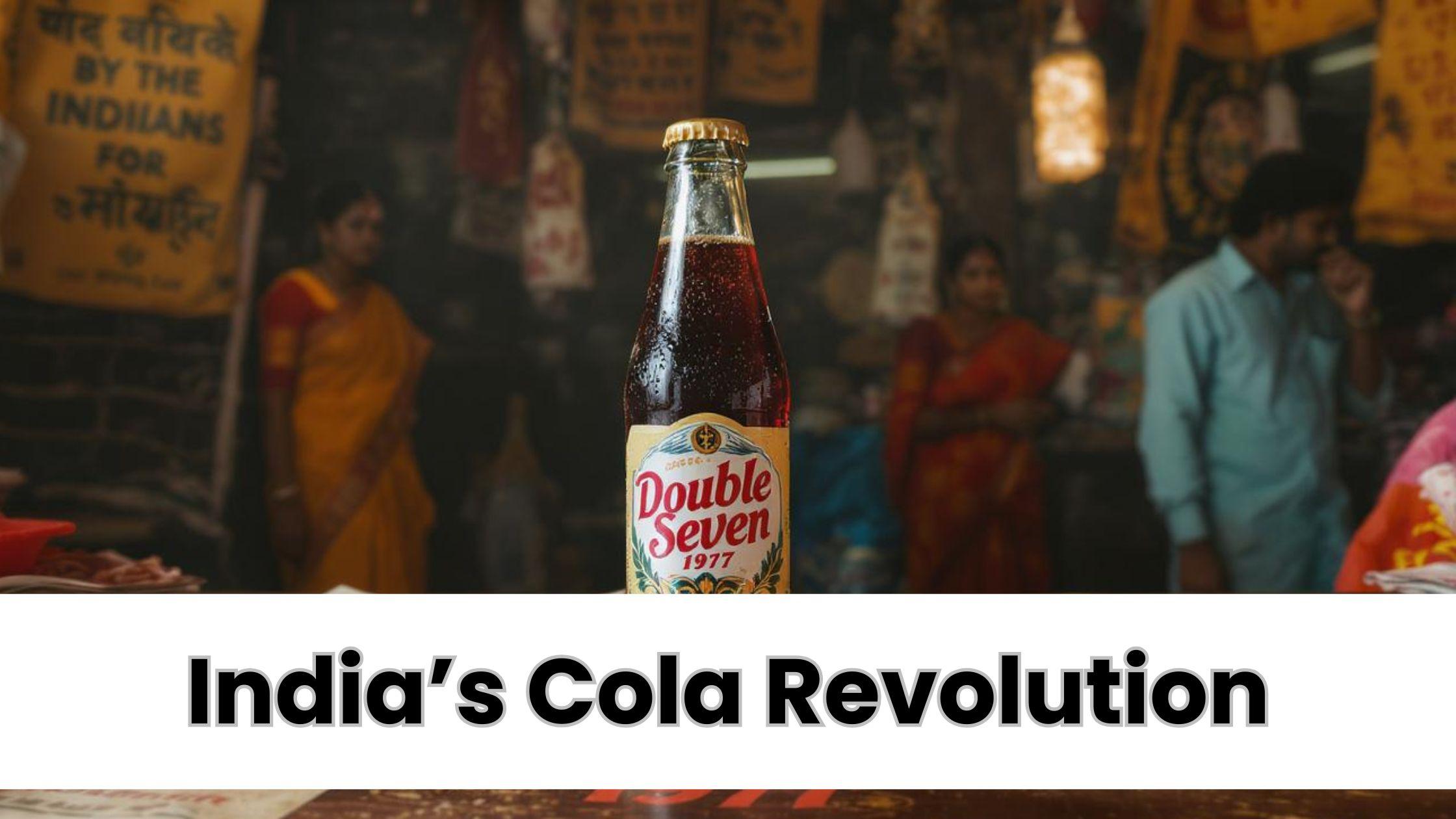Double Seven vs. Coca-Cola: A Cola War in 1977 India

In 1977, India saw a remarkable shift in its beverage industry with the introduction of Double Seven, a government-backed cola brand. This initiative was part of India’s Cola Revolution, aimed at reducing reliance on foreign brands and promoting indigenous products. The Janata Party, under the leadership of Morarji Desai, expelled Coca-Cola from the Indian market after the company refused to comply with the Foreign Exchange Regulation Act (FERA). Double Seven emerged as a patriotic alternative, representing India’s commitment to economic independence and self-reliance.
Government Initiative and Launch Strategy
Double Seven was produced by Modern Food Industries, a government-owned company, and officially launched at the Pragati Maidan trade fair in New Delhi. The brand name “Double Seven” was selected through a national competition, reflecting the year of its launch and the public’s enthusiasm for change. The formula was developed at the Central Food Technological Research Institute in Mysore to meet local taste preferences and ensure that the cola resonated with Indian consumers.
The government’s objective was to create a cola that was not only a substitute for Coca-Cola but also a symbol of national pride. Production and distribution were prioritized to ensure the product reached major urban centers and smaller towns alike, emphasizing accessibility and visibility.
Marketing: Nationalism and Consumer Appeal
Double Seven’s marketing strategy was innovative for its time, combining consumer appeal with patriotic messaging. Advertisements highlighted self-reliance, positioning Double Seven as more than a beverage—it was a statement of national pride. Slogans such as “For the good times” and “India’s own cola” became part of everyday conversation.
Celebrity endorsements helped amplify the brand’s message. Popular actors and public figures appeared in advertisements, linking Double Seven with India’s broader cultural resurgence post-Emergency. The campaign resonated with consumers, making the brand a symbol of the country’s determination to produce its own global-standard products.
Competition and Market Dynamics
Despite the advantages of government support, Double Seven faced stiff competition from domestic players such as Thums Up and Campa Cola. Thums Up, in particular, had already developed a loyal following due to its bold flavor and aggressive marketing campaigns. Campa Cola also had a regional presence, further intensifying competition.
While Double Seven initially struggled to match the taste profiles of its competitors, its government backing, widespread distribution, and symbolic significance allowed it to maintain a solid market presence for several years. Consumer loyalty was strengthened by the brand’s nationalistic positioning, which differentiated it from other domestic brands.
Consumer Reception and Cultural Impact
Double Seven became a cultural phenomenon. Purchasing the cola was seen as a patriotic act, with families choosing it over foreign alternatives. Schools and offices stocked it for celebrations, and local vendors promoted it as the Indian alternative to Coca-Cola.
The brand also influenced local media and pop culture. Newspapers, magazines, and radio shows highlighted the cola as a symbol of India’s industrial and economic capabilities. For many consumers, drinking Double Seven was a way of participating in India’s broader Cola Revolution and expressing support for national self-reliance.
Challenges and Operational Limitations
Despite its popularity, Double Seven faced challenges. Production infrastructure struggled to meet demand in some regions, leading to supply inconsistencies. Taste preferences varied across India, and some consumers preferred the stronger flavors of Thums Up or the regional familiarity of Campa Cola.
Additionally, while the brand benefited from patriotic marketing, it lacked the global marketing experience and operational efficiency of Coca-Cola. Packaging, distribution, and brand management limitations hindered its ability to compete fully in urban markets.
Decline Due to Political Shifts
Double Seven’s decline began in the early 1980s with the return of Indira Gandhi’s government. The new administration was less inclined to support a brand associated with the previous government. Without government backing, the brand gradually lost visibility, distribution, and consumer engagement.
By the mid-1980s, Double Seven’s presence in stores had diminished significantly. Competing domestic brands, such as Thums Up, continued to grow, while Coca-Cola remained absent until India’s economic liberalization in the 1990s.
Coca-Cola’s Return and Industry Transformation
Coca-Cola returned to India in 1993 following the country’s economic liberalization, along with PepsiCo, transforming the beverage industry. Global marketing strategies, large-scale investments, and aggressive campaigns reshaped consumer behavior. While Double Seven had disappeared, domestic brands like Thums Up adapted and thrived, maintaining strong consumer loyalty.
The Cola Revolution paved the way for a more competitive and diverse soft drink market in India, demonstrating that domestic brands could coexist with multinational corporations. Double Seven’s legacy persisted as a symbol of national pride and government-led industrial initiatives.
Legacy and Cultural Significance
Double Seven is remembered as more than a soft drink; it is a cultural icon representing India’s attempt to assert economic independence. Though its market presence was temporary, it influenced consumer attitudes, inspired other domestic brands, and highlighted the importance of national pride in product marketing.
Today, the story of Double Seven continues to be referenced in discussions about government-backed industries, consumer nationalism, and India’s evolving soft drink market. The Cola Revolution left an enduring legacy, reminding future generations of the country’s ambition to stand independently in global markets.
Read Full Article : https://bizinfopro.com/news/marketing-news/indias-cola-revolution-how-double-seven-replaced-coca-cola/
About Us : BizInfoPro is a modern business publication designed to inform, inspire, and empower decision-makers, entrepreneurs, and forward-thinking professionals. With a focus on practical insights and in‑depth analysis, it explores the evolving landscape of global business—covering emerging markets, industry innovations, strategic growth opportunities, and actionable content that supports smarter decision‑making.
- Vibnix Blog
- Politics
- News
- Liberia News
- Entertainment
- Technology
- Образование
- Art
- Causes
- Crafts
- Dance
- Drinks
- Film
- Fitness
- Food
- Игры
- Gardening
- Health
- Главная
- Literature
- Music
- Networking
- Другое
- Party
- Religion
- Shopping
- Sports
- Theater
- Wellness



